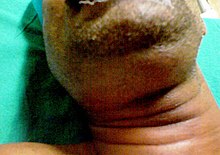Signs, Symptoms, and Diagnosis of Ludwig's angina
- Severe cellulitis of the floor of the mouth
- Bilateral lower facial swelling and upper neck swelling
- Elevation of the floor of the mouth and posterior displacement of the tongue
- Painful neck swelling
- Symptoms may include drooling, tooth pain, dysphagia, shortness of breath, fever, and general malaise
- Dental X-ray can identify infections originating in the roots of teeth
- CT scan of the neck with contrast material is used to identify deep neck space infections
- Chest scan may be done if there is suspicion of chest cavity infection
- Other possible diagnoses such as angioneurotic edema, lingual carcinoma, and sublingual hematoma should be ruled out
Causes and Microbiology of Ludwig's angina
- Dental infections account for 75-90% of cases
- Infections of lower second and third molars are common
- Other causes include oral ulcerations, infections secondary to oral malignancy, mandible fractures, and penetrating injuries of the mouth floor
- Patients with systemic illness such as diabetes mellitus and compromised immune system are predisposed
- Incidence of Ludwig angina is higher in patients with diabetes mellitus, acquired immune deficiency syndrome, and human immunodeficiency virus (HIV)
- Ludwigs angina is most often polymicrobial and anaerobic
- Commonly found microbes include Viridans streptococci, Staphylococci, Peptostreptococci, Prevotella, Porphyromonas, and Fusobacterium
- Traditional culture samples are time-consuming and sometimes unreliable
- Microbiology can be determined through culture samples
- Culture and sensitivity results guide antibiotic therapy
Treatment and Surgical Techniques for Ludwig's angina
- Treatment plan should consider stage of infection, airway control, and comorbidities
- Four principles guide treatment: sufficient airway management, early and aggressive antibiotic therapy, incision and drainage if necessary, and adequate nutrition and hydration support
- Airway management is the primary therapeutic concern and can involve endotracheal intubation or tracheostomy
- Antibiotic therapy is empirical until culture and sensitivity results are obtained
- Incision and drainage may be performed for localised abscesses or if medical management fails
- Indications for incision and drainage include airway compromise, septicaemia, deteriorating condition, descending infection, and diabetes mellitus
- Surgical techniques for incision and drainage include bilateral submandibular incisions, blunt dissection through the mylohyoid muscle, placement of Penrose drains, and debridement of necrotic tissue and thorough irrigation
- Post-operative care includes extubation when airway is patent, monitoring cultures and sensitivity tests, observing for signs of further infection or sepsis, monitoring white blood cell count, and repeating CT scans to assess health status and extent of infection
Nutritional Support for Ludwig's angina
- Adequate nutrition and hydration support is essential
- Difficulties in eating or swallowing may reduce food and fluid intake
- Well-nourished and hydrated patients promote wound healing and fight off infection
- Particularly important in young children following surgery
- Pain and swelling in the neck region can affect eating and swallowing
Etymology, Complications, and Follow-up of Ludwig's angina
- The term 'angina' is derived from the Latin word 'angere' meaning choke
- The term 'Ludwig's angina' refers to the feeling of strangling and choking due to airway obstruction
- The most serious potential complication of this condition is airway obstruction
- Complications of Ludwig's angina include spread of infection to the chest or other deep neck structures, septicemia, pneumonia, and mediastinitis
- Follow-up visits are necessary to ensure complete resolution of the infection.
Ludwig's angina (Latin: Angina ludovici) is a type of severe cellulitis involving the floor of the mouth and is often caused by bacterial sources. Early in the infection, the floor of the mouth raises due to swelling, leading to difficulty swallowing saliva. As a result, patients may present with drooling and difficulty speaking. As the condition worsens, the airway may be compromised and hardening of the spaces on both sides of the tongue may develop. Overall, this condition has a rapid onset over a few hours.
| Ludwig's angina | |
|---|---|
| Other names | Angina Ludovici |
 | |
| Swelling in the submandibular area in a person with Ludwig's angina. | |
| Specialty | Otorhinolaryngology, oral and maxillofacial surgery |
| Symptoms | Fever, pain, a raised tongue, trouble swallowing, neck swelling |
| Complications | Airway compromise |
| Usual onset | Rapid |
| Risk factors | Dental infection |
| Diagnostic method | Based on symptoms and examination, CT scan |
| Treatment | Antibiotics, corticosteroids, endotracheal intubation, tracheostomy |
The majority of cases follow a dental infection. Other causes include a parapharyngeal abscess, mandibular fracture, cut or piercing inside the mouth, or submandibular salivary stones. The infection spreads through the connective tissue of the floor of the mouth and is normally caused by infectious and invasive organisms such as Streptococcus, Staphylococcus, and Bacteroides.
Prevention is by appropriate dental care including management of dental infections. Initial treatment is generally with broad-spectrum antibiotics and corticosteroids. In more advanced cases endotracheal intubation or tracheostomy may be required.
With the advent of antibiotics in 1940s, improved oral and dental hygiene, and more aggressive surgical approaches for treatment, the risk of death due to Ludwig's angina has significantly reduced. It is named after a German physician, Wilhelm Frederick von Ludwig, who first described this condition in 1836.